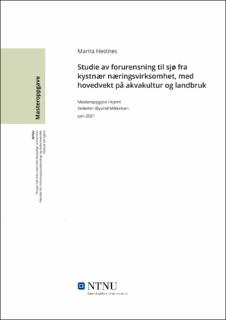| dc.contributor.advisor | Mikkelsen, Øyvind | |
| dc.contributor.author | Hestnes, Marita | |
| dc.date.accessioned | 2021-09-28T18:30:56Z | |
| dc.date.available | 2021-09-28T18:30:56Z | |
| dc.date.issued | 2021 | |
| dc.identifier | no.ntnu:inspera:77798433:14498596 | |
| dc.identifier.uri | https://hdl.handle.net/11250/2785502 | |
| dc.description.abstract | Kysten er et område av stor betydning i Norge, blant annet gjennom akvakultur som produserer store mengder mat og skaper mange arbeidsplasser. Kystområder kan påvirkes i negativ retning av for eksempel plastforurensning, oljesøl og utslipp av næringsstoffer og metaller. I denne oppgaven er et område ved en akvakulturlokalitet ved Nordleksa i Trondheimsleia undersøkt. Det ble tatt sedimentprøver i området ved hjelp av FF Gunnerus. Prøvene ble dekomponert ved bruk av UltraClave, og analysert for metaller med ICP-MS. Prøvene ble analysert for tungmetaller, som forbindes med industriutslipp, samt for teknologikritiske metaller, som benyttes i stadig større omfang. Resultatene fra ulike prøvepunkter ble sammenlignet med referanseområdet ved bruk av Mann-Whitney U-test for å se om forskjellene i metallkonsentrasjon var statistisk signifikante. Det ble også utført en prinsipal komponentanalyse på dataene for å se etter mønster som kan tyde på at metaller stammer fra samme kilde.
Det ble ikke funnet kvikksølv og selen i noen av prøvene, men flere andre tungmetaller ble bestemt. I to av punktene i nærheten av akvakulturanlegget ble det funnet signifikant lavere konsentrasjoner av krom, mangan, jern, nikkel, kobber, sink, tinn og vanadium i ett eller begge punktene sammenlignet med i referanseområdet. Det ble funnet signifikant høyere konsentrasjoner i enkelte av punktene i nærheten av anlegget sammenlignet med i referanseområdet av bly, kobber, sink, molybden, arsen og tinn. Det ble også bestemt flere teknologikritiske metaller, som var til stede i varierende konsentrasjoner. PCA pekte på en felles kilde for kalsium og arsen som påvirket to av punktene i området, og en felles kilde for bly og kobolt som påvirket et annet punkt. Trolig er kilden til kalsium og arsen skjell fra skalldyr, da de gjerne akkumulerer arsen i de kalsiumholdige skjellene sine. Den felles kilden til bly og kobolt var ikke like åpenbar, og det ble ikke trukket noen konklusjon på hva den kan være. | |
| dc.description.abstract | The coastal area is an area of great importance in Norway, amongst other things because of aquaculture which produces big amounts of food and creates a lot of jobs. The coastal area may be affected in a negative way by for example plastic contamination, oil spills and emissions of nutrients and metals. In this thesis an area close to an aquaculture facility by Nordleksa in Trondheimsleia was examined. Sediment samples from the area were collected by using FF Gunnerus. The samples were decomposed by using UltraClave and analyzed for metals by ICP-MS. The samples were analyzed for heavy metals, which are associated with industrial emissions, and for technology critical elements (TCEs) which are used in an increasing extent. The results for the different sampling points were compared by Mann-Whitney U-test to see if the difference in concentration of metals were statistically significant. A principal component analysis was performed on the data to look for groups of metals which might originate from a common source.
Mercury and selenium were not detected in any of the samples, but several other heavy metals were determined. In two of the points close to the aquaculture facility it was found to be significantly lower concentrations of chromium, manganese, iron, nickel, copper, zinc, tin and vanadium in one or both points compared to the reference area. It was found to be significantly higher concentrations in some of the points close to the facility compared to the reference area of lead, copper, zinc, molybdenum, arsenic and tin. Several TCEs, which were present in different concentrations, were also determined. The PCA pointed at a common source for calcium and arsenic which affected two of the points in the area, and a common source for lead and cobalt which affected another point in the area. The source of calcium and arsenic is most likely shells from shellfish which might accumulate arsenic in their shells who contain a lot of calcium. The common source for lead and cobalt was not clear, and there was not drawn a conclusion on what it might be. | |
| dc.language | nob | |
| dc.publisher | NTNU | |
| dc.title | Studie av forurensning til sjø fra kystnær næringsvirksomhet, med hovedvekt på akvakultur og landbruk | |
| dc.type | Master thesis | |
